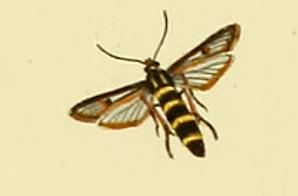
The Sesiidae or clearwing moths are a diurnal moth family in the order Lepidoptera known for their Batesian mimicry in both appearance and behaviour of various Hymenoptera.

Bembecia ichneumoniformis, the six-belted clearwing, is a moth of the family Sesiidae.
Bembecia albanensis is a moth of the family Sesiidae. It is found from most of Europe to Asia Minor and the Black Sea. It is also found in North Africa.
Bembecia blanka is a moth of the family Sesiidae. It is found on the Greek island of Crete.
Bembecia iberica is a moth of the family Sesiidae. It is found in France, Spain, Portugal and Italy and on Corsica and Sardinia.
Bembecia lomatiaeformis is a moth of the family Sesiidae. It is found from Greece to Turkey and the Caucasus.

Bembecia megillaeformis is a moth of the family Sesiidae. It is found in central and south-eastern Europe, east to Turkey, Uralsk, the Crimea and the Black Sea.
Bembecia priesneri is a moth of the family Sesiidae. It is found in Turkey and some nearby Dodecanese islands.
Bembecia sanguinolenta is a moth of the family Sesiidae. It is found from Bulgaria and Greece to Asia Minor, Armenia, Syria and Turkmenistan.

Microsphecia brosiformis is a moth of the family Sesiidae. It is found from the Balkan Peninsula to the Crimea, southern Russia (Sarepta), Asia Minor, the Caucasus, Iran, Turkmenistan and Afghanistan.
Bembecia stiziformis is a moth of the family Sesiidae. It is found on Cyprus and from Turkey to Iran, Turkmenistan and Pakistan.
Bembecia syzcjovi is a moth of the family Sesiidae. It is found in Turkey, Georgia and Iran.
Bembecia staryi is a moth of the family Sesiidae. It is found in the Kaçkar Mountains in Georgia and Turkey.

Pyropteron triannuliformis is a moth of the family Sesiidae. It is found from most of Europe to the Near East and Central Asia.
Pyropteron cirgisum is a moth of the family Sesiidae. It is found in scattered localities in Romania Ukraine, Russia, Azerbaijan, Turkey, Turkmenistan and Kazakhstan.
Chamaesphecia anatolica is a moth of the family Sesiidae. It is found in Turkey, Greece, Serbia and Montenegro, Romania and Hungary.
Bembecia sirphiformis is a moth of the family Sesiidae. It is found in France, Spain, Portugal and Italy. It is also found in North Africa.

Bembecia uroceriformis is a moth of the family Sesiidae. It is found in France, Spain, Portugal, Switzerland, Italy and most of the Balkan Peninsula. It is also found in North Africa and from Asia Minor to the Caucasus.

Bembecia vulcanica is a species of moth in the family Sesiidae. It is found on the Canary Islands.

Polyommatus admetus, the anomalous blue, is a butterfly of the family Lycaenidae. It was described by Eugenius Johann Christoph Esper in 1783. It is found in south-eastern Europe and Turkey.






